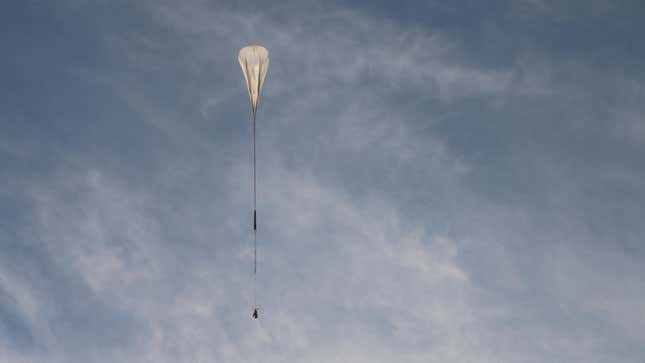
A unique telescope is set to launch from New Zealand in April 2022, designed to survey the gravitational lensing that occurs when galactic clusters collide. The instrument, called SuperBIT, will be suspended by a stadium-sized helium balloon in Earth’s stratosphere.
A team from the University of Toronto, Princeton University, and Durham University in England, in conjunction with NASA and the Canadian Space Agency, designed SuperBIT to be a demonstrative telescope, meant to show off a new technology (similar to the Ingenuity helicopter’s purpose on Mars). SuperBIT has a half-meter-wide mirror and will be lifted 25 miles into the sky by a balloon with a volume of 532,000 cubic meters. The telescope is budgeted to cost $5 million to both build and operate, a bargain compared to a space-based observatory.
The team’s astronomers and astrophysicists hope that SuperBIT will show the utility of a cheaper, more frequently launched telescopic system. By floating so high above nearly all of Earth’s atmosphere, the telescope will also avoid the stuff that so often screws up observations for land-based telescopes, from overcast nights to wildfire smog. A presentation on SuperBIT is set to be held tomorrow at the Royal Astronomical Society’s annual National Astronomy Meeting.

“[The James Webb Space Telescope] and almost all future planned missions that are high-resolution imagers are 500 nanometers or redder, which leaves Hubble as the only high-resolution imager that has blue and near-UV sensitivity,” said Mohamed Shaaban, an astrophysicist at the University of Toronto and a member of the SuperBIT team. “Not only is Hubble having all these tech scares, Hubble is older than I am. It’s an aging tech, it won’t last forever.”
Besides this, Shaaban added, Hubble is oversubscribed, meaning that the telescope has more work orders coming in that it can fill out. Shaaban said that SuperBIT and other balloon-borne telescopes could support Hubble’s role in space observation. (When the JWST and the Nancy Grace Roman Space Telescope become operational, they’ll shoulder a good bit of the burden of infrared observations that Hubble’s been handling alongside its insights in blue and near-ultraviolet spectra.)
The balloon is a super-pressure balloon, a development by NASA that will allow the telescope to stair airborne for many week and even months. That’s a needed departure from older balloon systems, like one heralded as a game-changer in 2014 that ended up springing a leak after two days, taking the gamma ray telescope it was carrying down with it. Up in the air, SuperBIT will circumnavigate the globe, imaging the sky at night and charging up by way of solar panels during the day. Shaaban said that the telescope will deploy hard drives of data by parachute when drifting over land, in addition to the regular beaming of data to the scientists on the ground. This, he said, will ensure that as much science as possible is recovered from the telescope, even if it eventually goes down in water.
SuperBIT is the precursor to GigaBIT, a planned telescope with an optical system three times the size of SuperBIT’s. According to the SuperBIT website, GigaBIT is expected to launch its first test flight in September 2022. Also in the 2022 launch window is the European Space Agency’s Euclid telescope, which like SuperBIT will be scouring space for signs of dark matter and dark energy.

“Euclid is going to be looking everywhere and a little bit shallow; SuperBIT and GigaBIT, from the science perspective, their niche is looking at something specific and looking deep,” Shaaban said. “We’re going to be able to see things that are dimmer and further away than Euclid by design.”
SuperBIT will observe colliding clusters of stars to measure properties of dark matter. The telescope does this by measuring gravitational lensing, the way that a big mass like a galaxy cluster bends light around itself. Because dark matter is invisible except through its gravity, gravitational lensing is a rare means of contemplating its nature. Seeing where dark matter is concentrated in galaxy clusters before and after those clusters collide will offer some insights as to if and how dark matter interacts with itself.
“Cavemen could smash rocks together, to see what they’re made of,” said Richard Massey, a physicist at Durham University and also a member of the SuperBIT team, in a Royal Astronomical Society release. “SuperBIT is looking for the crunch of dark matter. It’s the same experiment, you just need a space telescope to see it.”
First, the telescope needs to get off the ground and then stay aloft. If both those things happen, we could get a new perspective on the cosmos.
More: NASA’s Most Ambitious Scientific Balloon Collapsed After Two Days Aloft